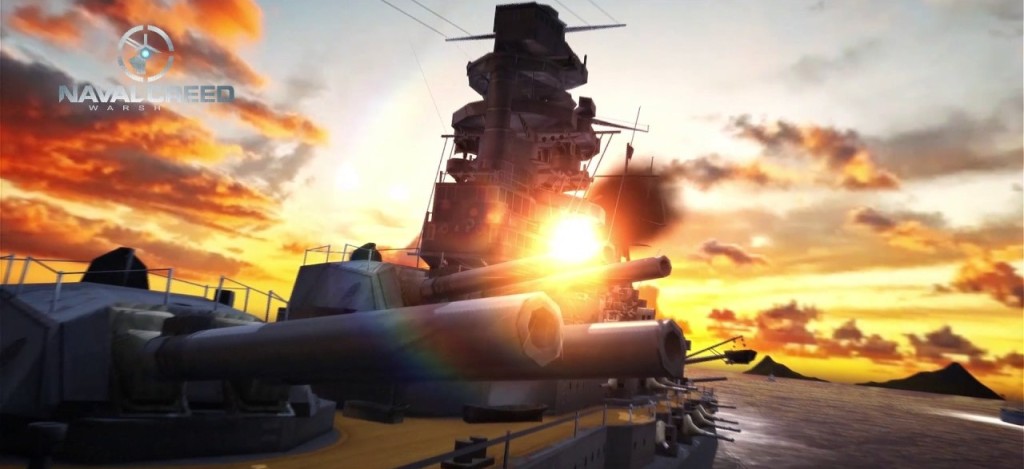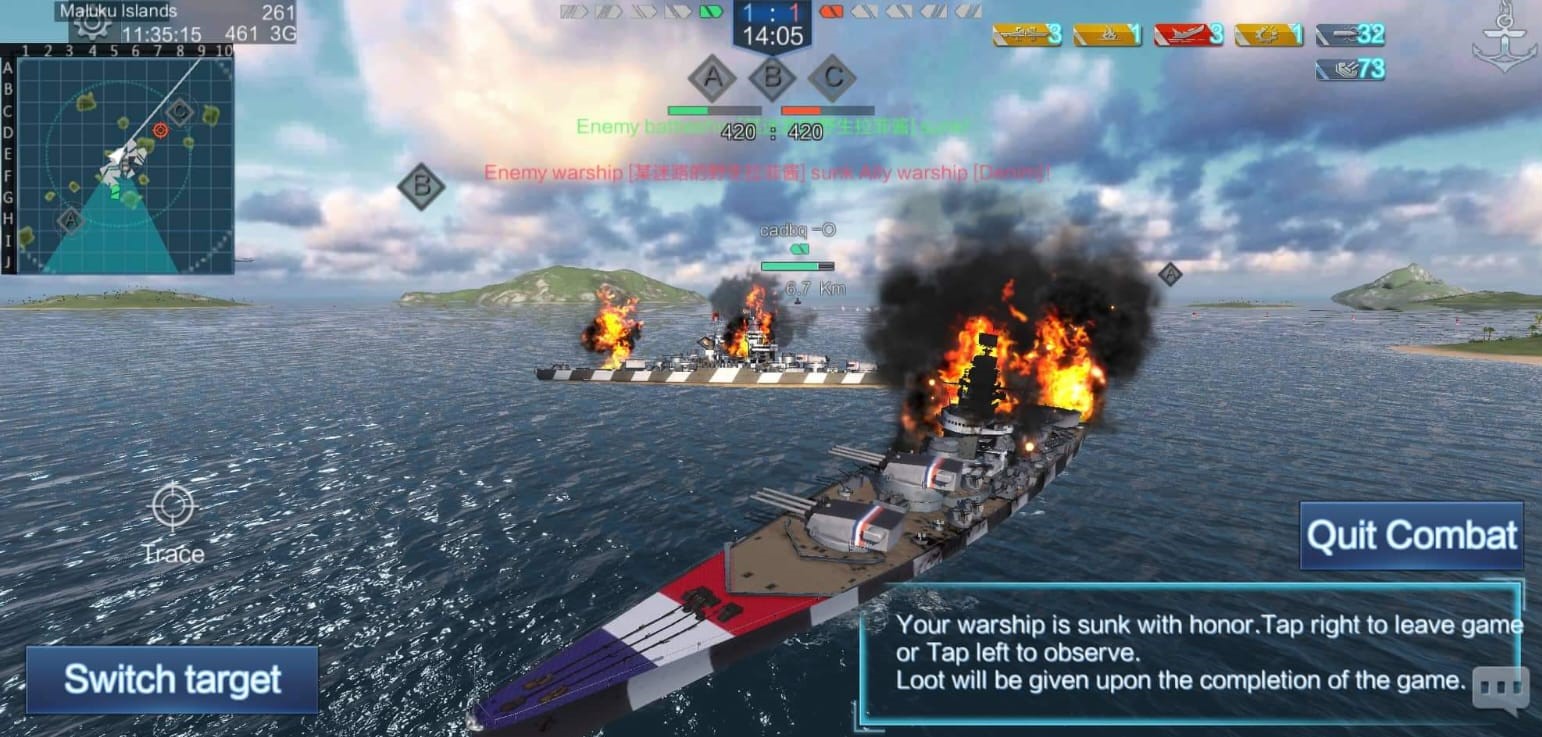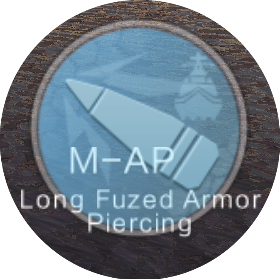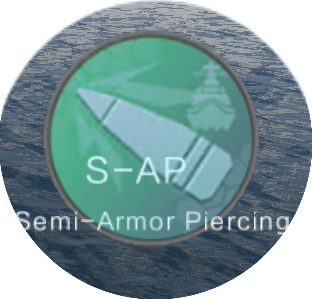Plot the demise of your enemy

Jump to section:
Damage type
Ammunition type
DAMAGE TYPE

Penetration
A shell that penetrates deal around 30% of maximum damage. The maximum damage of each shell can be seen in ship description. The penetration mechanism of each ammunition type is different and is explained below in the ammunition type section.

Citadel
A shell that penetrates and explodes inside the citadel deal maximum damage. We simply call the citadel damage as “citadel” for simplicity. A special ribbon is shown if you citadel an enemy. In order to penetrate into the citadel, the gun must have sufficient penetration and shell arming time. Technically, armor-piercing shells have the highest chance to inflict citadel damage due to their high penetration value, but even high-explosive shells can citadel some badly armored ships.
Shell arming time is the time between the shell’s first contact with ship armor and its detonation. There’s no way to know the shell arming time of each ship in Naval Creed. You have to use the ship and feel it.

Overpenetration
Overpenetration means the shell penetrates the armor, travels through the entire body without detonating, and gets out from the ship. The detonation happens after the shell gets out from the ship. This happens because the shell arming time is too high or the ship body is too thin that the shell doesn’t have time to detonate inside it. Overpenetration only deals around 10% of maximum damage. Overpenetration often happens when shooting at destroyers with armor-piercing (AP) shells because their hull is very thin. Overpenetration also often happens when the AP shells from a battleship hit the superstructure, bow, and stern of other ships from the side because those structures are thin without much armor protection.


Non-penetrations
The shell doesn’t penetrate because it shatters or bounces upon impact. No damage is inflicted. Angling the ship increases the chance to bounce shells that can otherwise penetrate or even citadel the ship. A very steep angling (0o-30o) usually will make even a large caliber AP shell to bounce, unless it overmatches the armor.
Overmatch
Every armor has a limit on how big the caliber of the guns it can bounce. If the caliber of the shell is too high, it will pierce the armor regardless of the angle of impact. For example, even though Jean Bart’s bow armor can bounce 406 mm AP, 510 mm AP from Super Yamato can penetrate it from the front because the bow can’t defend against AP shells as big as that.
Overmatch is only relevant when the shell hits the ship from direct front or stern. When fighting against ships that can citadel your ship from the bow, you can try to angle your ship so the shells hit the angled belt armor instead. This increases the chance of those shells to bounce. However, penetration mechanic applies to angling. If those shells have very high penetration value or you don’t angle sufficiently, they might still penetrate.

Fire
Fire is a type of damage over time caused by explosion of high explosive (HE) shell, semi armor piercing (SAP) shell, or bomb. A special ribbon is shown if you set a fire on the enemy. The chance of fire of each ammunition can be seen in the ship description. One fire has the duration of 45 seconds unless the player has modules, consumables, or crew skills that can reduce that duration. One full duration fire can reduce around 15% of HP. Ship can burn in 4 parts at the same time. Those parts are the bow, front superstructure, back superstructure, and stern. A fire set on a part that’s already burning will extend the duration of the fire. The status and location of fire is shown on the ship HP bar with black dot.

Flood
Flood is a type of damage over time caused by torpedo explosion. A special ribbon is shown if you set flood on the enemy. The chance of flood can be seen in the torpedo description. Flood has the duration of 60 seconds unless the player has modules, consumables, or crew skills that can reduce that duration. A full duration flood can reduce around 50% of HP and it’s often lethal in battle. Unlike fires, a ship can’t be flooded in 2 parts. The flood status is shown on the ship HP bar with blue triangle.
Ram/Collision

The damage that you inflict by ramming is the same as the total HP of your ship, and the damage that your receive is the same as the total HP of the enemy ship. For example, you’re using Lion and you’re ramming Jean Bart. Lion’s total HP is 80200, while Jean Bart’s total HP is 70400. Lion will receive 70400 damage while Jean Bart will receive 80200 damage. If both ships are at full HP before ramming, Lion will survive with 9800 HP while Jean Bart will sink because the damage taken is higher than its HP. However, If Lion’s HP before ramming is less than 70400, it will sink too.
Ramming is beneficial if your ship is already at low HP (or is going to sink soon) and the enemy ship still has a lot of HP. Ramming is also beneficial if the enemy is dangerous and by sinking him you can significantly increase the chance of victory. However, ramming is often considered a disrespectful act by many players. For example you’re about to lose a 1 vs 1 battle that was played fairly, your enemy has better skill than you, but then you decide to ram him. Yeah that’s disrespectful.
Saturation

If you attack the enemy ship so many times in one part, that part may become saturated and can’t receive damage anymore. Saturation rarely happens in this game, but light cruisers sometimes become a victim of this mechanic. The most common scenario is a light cruiser farming the superstructure of a high tier battleship. The light cruiser has rapid firing low caliber guns. The light cruiser hit the superstructure so many times that the superstructure becomes saturated and the cruiser can’t inflict damage anymore. If the part has been saturated, the only thing to do is attack another part that isn’t saturated.
AMMUNITION TYPE
Ships have two choices of main gun ammunition that you can use during the battle. The two most common ammunition choices are armor piercing (AP) and high explosive (HE). Some ships have long-fused armor piercing (MAP) or semi armor piercing (SAP) ammunition for their main guns. Some ships have torpedoes or planes that can launch bombs and torpedoes. Each ammunition type has their own strengths and weaknesses. Understanding each ammunition’s characteristics is vital to maximize your damage output.

Armor Piercing (AP)
Armor piercing (AP) shell has very high armor penetration ability and can deal a lot of damage. The AP shell has the highest maximum damage among all ammunition types. It has white tracer color. The principles of AP shell penetration are as follows:
- Bigger caliber guns tend to have higher penetration and therefore has better chance to citadel enemies.
- Penetration reduces gradually the steeper the angle of impact is. If the angle is too steep, the AP shell might not even penetrate and just bounces, dealing no damage. This is why the best method to mitigate damage from AP shell is angle your ship. Don’t be a foolish person that shows broadside when the enemy battleship is looking at you. You’ll get deleted quickly.
- Penetration reduces gradually the farther the enemy ship is. The range and air drag reduces the shell velocity. Aside from that, shells that travel a long distance tend to impact from above, hitting the deck instead of the side armor.
- Each ship has its own basic penetration value. For example, Iowa’s AP has better penetration than Admiral Nakhimov, even though they have the same caliber (406 mm). However, this rule doesn’t apply to overmatch mechanic. The 406 mm AP from Nakhimov, even though it has bad penetration, can still overmatch Neptune’s armor and penetrate it from the bow. The basic penetration value can’t be seen from the ship description and the player must feel it to know how it performs.
AP is the best ammo to penetrate the side armor of ships especially when they’re showing broadside. A well-aimed AP with sufficient penetration can citadel the enemy and inflict a lot of damage. That’s why AP should be the primary ammunition type of most battleships. Some ships that have terrible HE (for example British light cruisers) should also use AP as the primary ammunition.

High-explosive (HE)
High-explosive shells explode upon impact and will penetrate the armor as long as the thickness is below the penetration threshold. HE shells don’t care about angling or range. If the HE shell has very high penetration threshold, it might citadel badly armored ships. The penetration threshold is different from each ship and often doesn’t relate to the caliber. The penetration threshold can be seen from the gun description.
If the HE shell penetrates, it will explode inside the armor and probably cause fire. The fire chance can be seen from the gun description. An HE shell that doesn’t penetrate might still cause fire but the chance is much lower. This is why an indicator of good HE performance is penetration. The damage that’s caused by HE shell is usually much lower than AP and it can’t penetrate the belt armor of battleships because their belt armor thickness far exceeds the penetration threshold. However, the fires set on the superstructure and deck can be a lot more dangerous. For ships that have powerful HE such as British heavy cruisers, HE should be the primary ammunition choice.

Long-fused Armor Piercing (MAP)
Long-fused armor piercing (MAP) is an ammunition type that can be found on British ships. Despite the name, MAP actually has very different mechanism from AP. MAP penetrates armor based on penetration threshold, much like HE. So if the armor thickness is below the penetration threshold, MAP will penetrate regardless of angle. MAP’s penetration threshold cannot be seen from gun description, but it is much higher than HE. It can penetrate the bow armor of all ships in the game and even citadel battleships from the front. Even though Montana’s bow cannot be penetrated by Super Yamato’s 510 mm AP, 406 mm MAP from Lion can penetrate and citadel it. On the other hand, MAP shell is rarely able to penetrate the belt armor of battleships (just like HE) because their belt armor thickness exceeds the MAP penetration threshold. So if the enemy is broadsiding, AP is still the superior ammunition. Unlike HE, MAP can’t set fires.

Semi Armor Piercing (SAP)
Semi armor piercing is an ammunition type that can only be found on Mikhail Kutuzov. SAP works like AP with slightly lower basic penetration value but has a small chance to set fires. Yes, it’s an AP that can set fires. If the enemy is broadsiding, Mikhail Kutuzov’s SAP can deal massive penetration damage while also setting them on fire. Because the penetration mechanism is like AP, the best way to mitigate damage from SAP is angle the ship. That way, SAP can only penetrate some lightly armored superstructure (dealing minimal damage) and lower the chance of fire (which is already very low).
Bomb
Bombs can only be dropped by dive bombers. All CVs and some Japanese cruisers have dive bombers. Bombs have low damage compared to torpedoes, but the fire chance is more than 80%. A squadron of dive bombers often cause fires in multiple locations.
Torpedo
There are two types of torpedoes: ship-launched and plane-launched. Ship-launched torpedoes usually have faster speed and higher damage than plane-launched torpedoes, but plane-launched torpedoes are far more precise. The high precision of torpedoes from torpedoplanes makes the damage output very high. All torpedoes have a very high chance to cause flood. Don’t be fooled by the torpedoplane specification in CVs. Even though their flood chance looks low, in actual battle it’s more than 80%.
Leave a comment